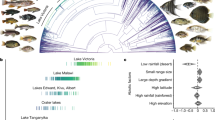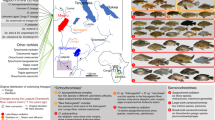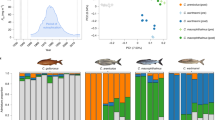Abstract
Species diversity can be lost through two different but potentially interacting extinction processes: demographic decline and speciation reversal through introgressive hybridization. To investigate the relative contribution of these processes, we analysed historical and contemporary data of replicate whitefish radiations from 17 pre-alpine European lakes and reconstructed changes in genetic species differentiation through time using historical samples. Here we provide evidence that species diversity evolved in response to ecological opportunity, and that eutrophication, by diminishing this opportunity, has driven extinctions through speciation reversal and demographic decline. Across the radiations, the magnitude of eutrophication explains the pattern of species loss and levels of genetic and functional distinctiveness among remaining species. We argue that extinction by speciation reversal may be more widespread than currently appreciated. Preventing such extinctions will require that conservation efforts not only target existing species but identify and protect the ecological and evolutionary processes that generate and maintain species.
This is a preview of subscription content, access via your institution
Access options
Subscribe to this journal
Receive 51 print issues and online access
$199.00 per year
only $3.90 per issue
Buy this article
- Purchase on Springer Link
- Instant access to full article PDF
Prices may be subject to local taxes which are calculated during checkout



Similar content being viewed by others
References
Chapin, F. S. et al. Consequences of changing biodiversity. Nature 405, 234–242 (2000)
Rosenzweig, M. L. Loss of speciation rate will impoverish future diversity. Proc. Natl Acad. Sci. USA 98, 5404–5410 (2001)
Rhymer, J. M. & Simberloff, D. Extinction by hybridization and introgression. Annu. Rev. Ecol. Syst. 27, 83–109 (1996)
Seehausen, O. Losing biodiversity by reverse speciation. Curr. Biol. 16, R334––R337 (2006)
Seehausen, O., Van Alphen, J. J. M. & Witte, F. Cichlid fish diversity threatened by eutrophication that curbs sexual selection. Science 277, 1808–1811 (1997)
Taylor, E. B. et al. Speciation in reverse: morphological and genetic evidence of the collapse of a three-spined stickleback (Gasterosteus aculeatus) species pair. Mol. Ecol. 15, 343–355 (2006)
Grant, B. R. & Grant, P. R. Fission and fusion of Darwin’s finches populations. Proc. R. Soc. B 363, 2821–2829 (2008)
Gilman, R. T. & Behm, J. E. Hybridization, species collapse, and species reemergence after disturbance to premating mechanisms of reproductive isolation. Evolution 65, 2592–2605 (2011)
Schluter, D. The Ecology of Adaptive Radiation (Oxford Univ. Press, 2000)
Coyne, J. A. & Orr, H. A. Speciation (Sinauer Associates, 2004)
Rundle, H. D. & Nosil, P. Ecological speciation. Ecol. Lett. 8, 336–352 (2005)
Schluter, D. Evidence for ecological speciation and its alternative. Science 323, 737–741 (2009)
Servedio, M. R. et al. Magic traits in speciation: ‘magic’ but not rare? Trends Ecol. Evol. 26, 389–397 (2011)
Hendry, A. P. et al. Possible human impacts on adaptive radiation: beak size bimodality in Darwin's finches. Proc. R. Soc. B 273, 1887–1894 (2006)
De León, L. F. et al. Exploring possible human influences on the evolution of Darwin’s finches. Evolution. 65, 2258–2272 (2011)
Schluter, D. Ecological speciation in postglacial fishes. Proc. R. Soc.. B 351, 807–814 (1996)
Rundle, H. D., Nagel, L., Boughman, J. W. & Schluter, D. Natural selection and parallel speciation in sympatric sticklebacks. Science 287, 306–308 (2000)
Hudson, A. G., Vonlanthen, P. & Seehausen, O. Rapid parallel adaptive radiations from a single hybridogenic ancestral population. Proc. R. Soc. B 278, 58–66 (2011)
Bernatchez, L. in Evolution Illuminated (eds Hendry, A. P. & Stearns, S. C. ) 175–207 (Oxford Univ. Press, 2004)
McPhail, J. D. Ecology and evolution of sympatric sticklebacks (Gasterosteus)—origin of the species pairs. Can. J. Zool. 71, 515–523 (1993)
Kottelat, M. & Freyhof, J. Handbook of European Freshwater Fishes (Kottelat, Cornol and Freyhof, 2007)
Steinmann, P. Monographie der schweizerischen koregonen. Beitrag zum problem der entstehung neuer arten. Spezieller teil. Schweiz. Z. Hydrobiol. 12, 340–491 (1950)
Vonlanthen, P. et al. Divergence along a steep ecological gradient in lake whitefish (Coregonus sp.). J. Evol. Biol. 22, 498–514 (2009)
Woods, P. J., Müller, R. & Seehausen, O. Intergenomic epistasis causes asynchronous hatch times in whitefish hybrids, but only when parental ecotypes differ. J. Evol. Biol. 22, 2305–2319 (2009)
Müller, R. & Stadelmann, P. Fish habitat requirements as the basis for rehabilitation of eutrophic lakes by oxygenation. Fish. Mgmt. Ecol. 11, 251–260 (2004)
Verschuren, D. et al. History and timing of human impact on Lake Victoria, East Africa. Proc. R. Soc. B 269, 289–294 (2002)
Smith, V. H. & Schindler, D. W. Eutrophication science: where do we go from here? Trends Ecol. Evol. 24, 201–207 (2009)
Straile, D. & Geller, W. The response of Daphnia to changes in trophic status and weather patterns: a case study from Lake Constance. ICES J. Mar. Sci. 55, 775–782 (1998)
Jeppesen, E., Jensen, J. P., Søndergaard, M., Lauridsen, T. & Landkildehus, F. Trophic structure, species richness and biodiversity in Danish lakes: changes along a phosphorus gradient. Freshwat. Biol. 45, 201–218 (2000)
Blumenshine, S. C., Vadeboncoeur, Y., Lodge, D. M., Cottingham, K. L. & Knight, S. E. Benthic-pelagic links: responses of benthos to water-column nutrient enrichment. J. N. Am. Benthol. Soc. 16, 466–479 (1997)
Powers, S. P. et al. Effects of eutrophication on bottom habitat and prey resources of demersal fishes. Mar. Ecol. Prog. Ser. 302, 233–243 (2005)
Waples, R. S. & Do, C. Linkage disequilibrium estimates of contemporary Ne using highly variable genetic markers: a largely untapped resource for applied conservation and evolution. Evol. Appl. 3, 244–262 (2010)
Bittner, D., Excoffier, L. & Largiader, C. R. Patterns of morphological changes and hybridization between sympatric whitefish morphs (Coregonus spp.) in a Swiss lake: a role for eutrophication? Mol. Ecol. 19, 2152–2167 (2010)
Seehausen, O. et al. Speciation through sensory drive in cichlid fish. Nature 455, 620–623 (2008)
Heath, D., Bettles, C. M. & Roff, D. Environmental factors associated with reproductive barrier breakdown in sympatric trout populations on Vancouver Island. Evol. Appl. 3, 77–90 (2010)
Brede, N. et al. The impact of human-made ecological changes on the genetic architecture of Daphnia species. Proc. Natl Acad. Sci. USA 106, 4758–4763 (2009)
Harmon, L. J. et al. Evolutionary diversification in stickleback affects ecosystem functioning. Nature 458, 1167–1170 (2009)
Goldschmidt, T., Witte, F. & Wanink, J. Cascading effects of the introduced Nile perch on the detritivorous phytoplanktivorous species in the sublittoral areas of Lake Victoria. Conserv. Biol. 7, 686–700 (1993)
Seehausen, O. Speciation affects ecosystems. Nature 458, 1122–1123 (2009)
Faith, D. P. et al. Evosystem services: an evolutionary perspective on the links between biodiversity and human well-being. Curr. Opin. Env. Sust. 2, 1–9 (2010)
Pritchard, J. K., Stephens, M. & Donnelly, P. Inference of population structure using multilocus genotype data. Genetics 155, 945–959 (2000)
Liechti, P. Der Zustand der Seen in der Schweiz (Schriftenreihe Umwelt Nr. 237; Bundesamt für Umwelt, Wald und Landschaft, 1994)
Müller, R. Trophic state and its implications for natural reproduction of salmonid fish. Hydrobiologia 243, 261–268 (1992)
Harrod, C., Mallela, J. & Kahilainen, K. K. Phenotype-environment correlations in a putative whitefish adaptive radiation. J. Anim. Ecol. 79, 1057–1068 (2010)
Latch, E. K., Dharmarajan, G., Glaubitz, J. C. & Rhodes, O. E. Relative performance of Bayesian clustering software for inferring population substructure and individual assignment at low levels of population differentiation. Conserv. Genet. 7, 295–302 (2006)
Wasko, A. P., Martins, C., Oliveira, C. & Foresti, F. Non-destructive genetic sampling in fish. An improved method for DNA extraction from fish fins and scales. Hereditas 138, 161–165 (2003)
Czerkies, P., Kordalski, K., Golas, T., Krysinski, D. & Luczynski, M. Oxygen requirements of whitefish and vendace (Coregoninae) embryos at final stages of their development. Aquaculture 211, 375–385 (2002)
Acknowledgements
We thank all professional fishermen who provided fish specimens. We thank M. Kugler from the Amt für Natur, Jagd und Fischerei, St. Gallen and the institute of Seenforschung and Fischereiwesen Langenargen for providing historical whitefish scales from Lake Constance. We acknowledge the Swiss Federal Institute for Aquatic Science and Technology (EAWAG), the Internationale Gewässerschutzkomission für den Bodensee (IGKB) and the Federal Office for Environment (FOEN) for providing environmental data. We also thank G. Périat, S. Mwaiko, M. Barluenga, H. Araki, M. Maan, J. Brodersen, P. Nosil, K. Wagner and all members of the Fish Ecology and Evolution laboratory for assistance in the laboratory, and for comments and suggestions on the manuscript, B. Müller for help with the analysis of the oxygen profiles, and C. Melian for help with data analyses. We acknowledge financial support by the Eawag Action Field Grant ‘AquaDiverse–understanding and predicting changes in aquatic biodiversity’ (to O.S.).
Author information
Authors and Affiliations
Contributions
P.V. contributed to conception and design of the study, collected fish, generated gill-raker and contemporary genetic data, and carried out most of the statistical analyses. D.B. collected fish, generated gill-raker, historical and contemporary genetic data. A.G.H. collected fish and generated gill-raker and geometric morphometric data. K.A.Y. participated in designing the study and writing the manuscript. R. M. collected and analysed egg data and contributed to fish collection. B.L.-H. contributed to fish, gill-raker, and genetic data collection. D.R. contributed to analyses and writing. S.D.P. contributed to collection of historical genetic data. C.R.L. supervised parts of sampling, gill-raker counting and contemporary genetic data collection. O.S. conceived and designed the project, supervised the project, and contributed to data analyses. P.V. and O.S. wrote the paper.
Corresponding author
Ethics declarations
Competing interests
The authors declare no competing financial interests.
Supplementary information
Supplementary Information
This file contains Supplementary Text and Data, Supplementary References Supplementary Tables 1-7 and Supplementary Figures 1-7 with legends. (PDF 870 kb)
Rights and permissions
About this article
Cite this article
Vonlanthen, P., Bittner, D., Hudson, A. et al. Eutrophication causes speciation reversal in whitefish adaptive radiations. Nature 482, 357–362 (2012). https://doi.org/10.1038/nature10824
Received:
Accepted:
Published:
Issue Date:
DOI: https://doi.org/10.1038/nature10824
This article is cited by
-
Bacterioplankton Assembly Along a Eutrophication Gradient Is Mainly Structured by Environmental Filtering, Including Indirect Effects of Phytoplankton Composition
Microbial Ecology (2023)
-
Genomic architecture of adaptive radiation and hybridization in Alpine whitefish
Nature Communications (2022)
-
Genomic variation from an extinct species is retained in the extant radiation following speciation reversal
Nature Ecology & Evolution (2022)
-
The origin of the parrotfish species Scarus compressus in the Tropical Eastern Pacific: region-wide hybridization between ancient species pairs
BMC Ecology and Evolution (2021)
-
Genetic relationships between sympatric and allopatric Coregonus ciscoes in North and Central Europe
BMC Ecology and Evolution (2021)
Comments
By submitting a comment you agree to abide by our Terms and Community Guidelines. If you find something abusive or that does not comply with our terms or guidelines please flag it as inappropriate.



